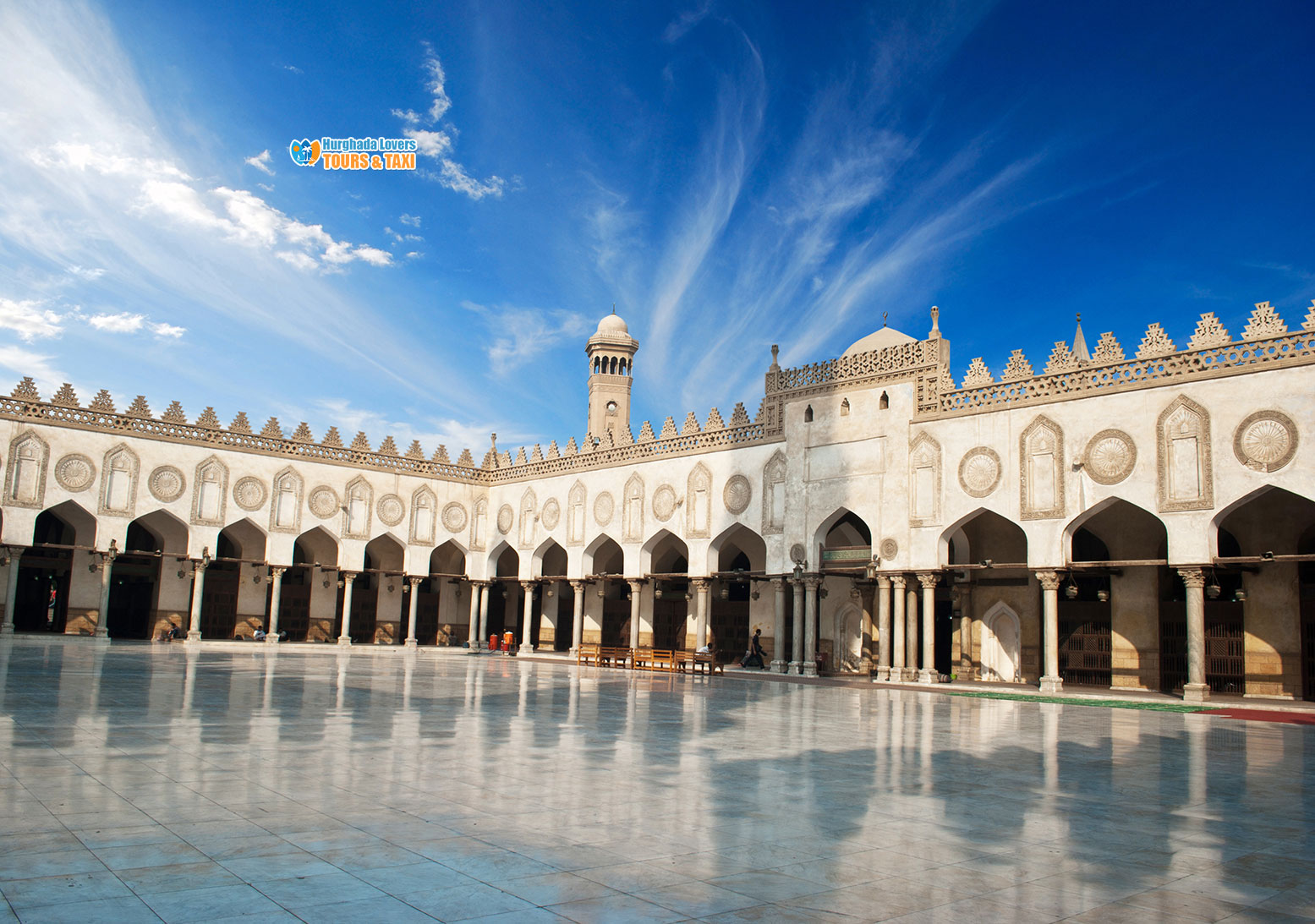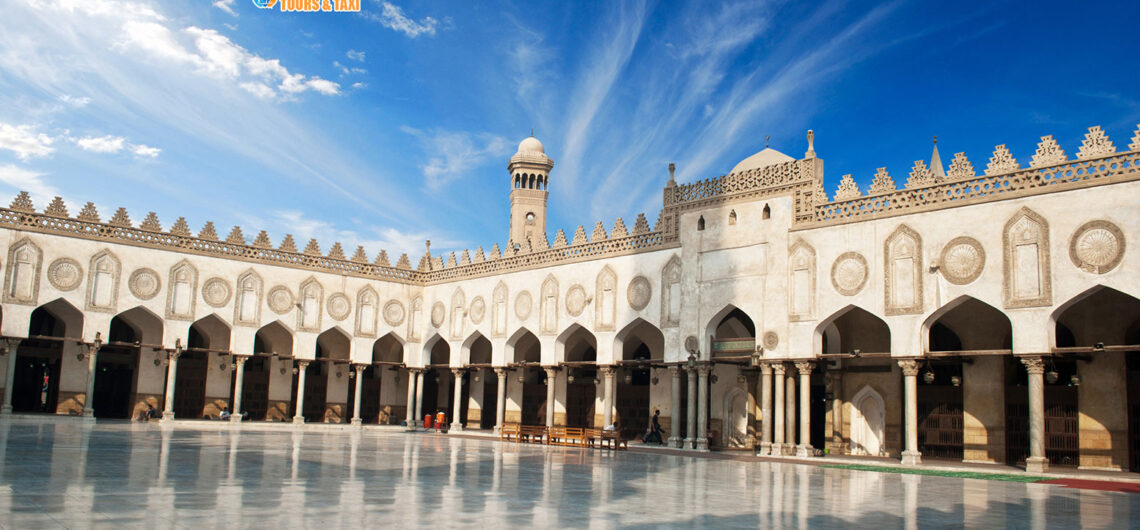Al-Azhar Mosque in Cairo, Egypt | Map, facts and history of the establishment of the most famous Islamic mosques in the Islamic world, who built the Al-Azhar Mosque, the design of the mosque from the inside and more.
Al-Azhar Mosque is one of the most important mosques in Egypt. It is considered one of the sources of knowledge and the dissemination of Islam. It is even a source of knowledge for Muslims around the world, not only for the Egyptians. In addition to its archaeological importance, learn more about Al-Azhar Mosque below.
Hurghada lovers Offer Luxury Hurghada to Pyramids Tours | El Gouna to Pyramids Tours | Makadi bay to Pyramids Tours | Sahl Hasheesh to Pyramids Tours | Soma bay to Pyramids Tours .
Who is the founder of Al-Azhar Mosque?
Al-Muizz Li Din Allah is the founder of Al-Azhar Mosque.
When was Al-Azhar Mosque built?
Construction began in 970 AD to 972 AD.
How many minarets are there in Al-Azhar Mosque?
There are 4 minarets in Al-Azhar Mosque.
Al-Azhar Mosque
Al-Azhar Mosque in Cairo is a history of the mosque and what are the most important minarets, schools, and gates of the mosque where it is considered one of the most important Islamic historical monuments in Egypt and what is the role of Al-Azhar in the Islamic world and more.
The mosque was built in 969 AD, 359 Hijri, where the commander Jawhar Al-Seqelly, ruler of Egypt and commander of the back lines, who is a supporter of the Fatimids who gave the order to build the largest and oldest Islamic university in history and the whole world.
The mosque is located on al-Azhar’s main street, stretching from Al Hussein Square to Ataba Square.
In the beginning, the mosque was built as a great mosque for Cairo, and in 378 Hijri the mosque was transformed into a large mosque to teach the sciences of jurisprudence and religion to students from all over the world.
A law on al-Azhar Mosque was passed in 1961 to become a scientifically advanced Islamic university while retaining religious teachings and traditions.
You can visit the mosque and walk around provided you take off your shoes, where you can hold them in your hand or put them in the closet of the mosque.
The mosque has a high minaret, with a high body with 17 sides and covered from the outside with the most beautiful tiles then ends with two crescents, which was built during the reign of Sultan Al-Ghuri in 920 hijri, 1514 AD. au 16th century. When you enter the hallway, you will see a large square and pointed arches from the Fatimid period, the 10th and 11th centuries AD, as well as the places of instruction for students and the dome at the main entrance of the al-Azhar Mosque.
For 1,000 years, the mosque underwent significant expansions from the inside until it reached its current status, along with the original columns and some ancient columns in place before the construction of the mosque, where Sultan Qaitbay renovated the entrance to the original mosque in 891 Hijri, then Sultan Abdul Rahman Katkhoda enlarged it in 1167 Hijri. The foundation stone for the construction of the mosque was laid on 14 Ramadan 359 Hijri and approved 970 AD until the completion of the entire construction in the holy month of Ramadan of 361 Hijri, 972 AD.
The name of al-Azhar Mosque is due to its location at the end of Al-Azhar Street and some explanations are said that the reason for its name is according to Fatima al-Zahra, daughter of the Prophet Mohammad that peace be upon him. Sunni doctrine as well as Islamic law are taught at al-Azhar Mosque to Egyptian students and expatriates from all over the world.
The mosque can accommodate more than 2,000 worshippers, Bab al-Saaida, founded by Sultan Abdul Rahman Katkhoda Bab al-Sharba and founded by Sultan Abdul Rahman Katkhoda Bab al-Mazinin and founded by Khedive Abbas Helmi II.
Minarets in al-Azhar Mosque: The minaret of Aqabayya Abdul Wahid was founded in 740 Hijri in the Fatimid period, the minaret of Sultan Qaitbay, and was established in 891 Hijri in the Fatimid period, the minaret of Qonsoa al-Ghuri and has two heads, and was established in 915 Hijri in the Fatimid period, the minaret of Sultan Abdul Rahman Katkhoda and was established in 1167 Hijri in Ottoman times.
The schools in al-Azhar Al-Sharif Mosque:
The Tyrceya School, located to the right of the main entrance and established in 709 Hijri in the Mamluk period freely, is located to the left of the main entrance and was established in 741 Hijri in the Mamluk era freely the school of Johar al-Qanqabi and was established in 844 Hijri in the Mamluk Jerkes era figures buried in the mosque: The cemetery of the southern corner of Sultan Abdul Rahman Katkhoda , the cemetery of the eastern corner of Sultan Jawhar al-Qanqabi, the main niches of the al-Azhar Al-Sharif Mosque: the warrior of Jawhar al-Seqelly, the warrior of Sultan Abdul Rahman Katkhoda.
Information about Al-Azhar Mosque
• The construction of Al-Azhar Mosque dates back to the era of the Fatimid state, and this era came after the completion of the conquest of Egypt by Jawhar Al-Siqilli in the year 969AD.
• Jawhar Al-Siqilli started establishing Cairo and established the Grand Palace, and after that came the Caliph Al-Mu’izz Li-Din Allah, who started building this mosque.
• The goal was to build this mosque so that there would be a mosque in Medina and an educational institute for the Shiite sect and its dissemination.
• The mosque was built in the Fatimid architectural style, despite the restoration operations that have continued over the ages until now, which have changed the features of the architectural style.
• However, so far it is considered one of the oldest Fatimid monuments.
• Al-Azhar Mosque is considered one of the oldest existing universities in the world. It is the first in Egypt to play the role of a school and institute.
• The lessons of the mosque in the past were given on the basis of a mandate from the state, and scholars and teachers receive a fee for the lessons.
• The fall of the Fatimid state was a strong reason for the decline in the prosperity of the mosque at the hands of Salah al-Din al-Ayyubi, who was fighting the Shiite sect.
The sermon remained suspended in the mosque for 100 years until the Mamluk Sultan al-Zahir Baybars al-Bunduqdari restored it.
• During the reign of King Fouad I, he issued a law establishing the faculties of theology, Sharia and Arabic language, and in 1961 the mosque became an independent university.
What is behind the name Al-Azhar Mosque?
• The mosque was initially called Al-Mansuriya Mosque, but with the era of the Caliph Al-Mu’izz Li-Din Allah, he named the city in Cairo, and thus the mosque became called the Cairo Mosque.
• Al-Azhar is the male form of the word Al-Zahra, which is the title of Lady Fatima, the daughter of the Messenger, may God bless him and grant him peace, and the wife of Ali bin Abi Talib.
Al-Azhar Mosque in the era of the Ottoman Empire
• The beginning of the Ottoman Caliphate The Al-Azhar Mosque was highly respected by the Ottomans, as Sultan Selim I attended the Friday prayer at Al-Azhar Mosque when he entered Egypt.
• The Ottoman princes also attended Friday prayers regularly in the mosque.
• The Ottomans provided wages to students and teachers.
• The Mamluk Qazdugli Bey made a number of renovations in the 18th century and even added a gallery for blind students in 1735 AD.
• Abd al-Rahman Katkhuda also completed the expansions of the mosque in 1749 AD.
• Al-Azhar regained its prosperity again in the Ottoman Empire, until the mosque became closely associated with the religious scholars in Egypt.
Al-Azhar Mosque building
• The expansions and additions that were made to the mosque changed the features of the Fatimid architectural style of the mosque, but so far it still includes features of this style.
• Domes are additions that were added during the Ottoman era, in addition to the minarets, which date back to the Mamluk era.
• The mosque was built on 5 corridors in addition to a central courtyard with a large prayer hall.
• The gates were added during the Ottoman rule and the old mihrab was replaced with a new one.
• Until now, there are original minarets and domes inside the mosque, while some have been restored.
• One of the Ottoman renovations that took place in the mosque is the Muzayin Gate, which is the main gate of the mosque.
• The drink door and the door of the Sa’ida are other additions.
Al Ghouri Minaret
• Al-Ghouri minaret is one of the minarets in the mosque. It is a double-headed minaret.
• The minaret was built in 1509 AD during the reign of Qanswa al-Ghouri. This minaret is located on a square base, while its lower part is octagonal.
• The four sides of it are arched with ornate beams, and the central area is separated from the lower part by using cubic balconies supported by muqarnas.
• The upper part has a square bearing two heads and a copper crescent on top.
• One of the doors in the mosque is Bab al-Jundi or what is known as Bab Qaitbay, which comes directly after the entrance to Bab al-Muzainin.
• Among the other minarets in the mosque is the minaret of Qaitbay, which was built in 1483 AD and comes in the form of a cylindrical column.
• The column is divided into two parts, and the minaret consists of 3 balconies.
• The minaret comes in the form of a vaulted ceiling and the lower part is decorated with paintings.
Time to visit Al-Azhar Mosque
Daily from dawn until after evening prayer and without fees.


